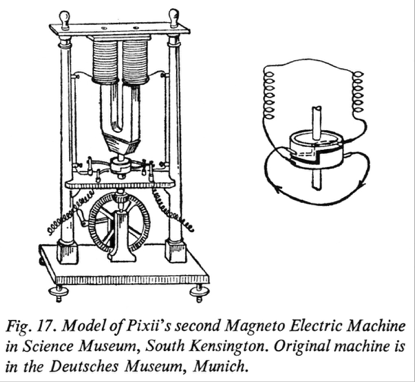
Richie's Apparatus of 1828
This item is a motor; there is no mechanical drive, The model has a metallic commutator. One reference I have is that Sturgeon invented the metallic commutator about 1836 and that previously, mercury had been used for commutators. Another reference says that Sturgeon invented the commutator, as we know it, that is, the metallic commutator, in 1832.
In 1832, Ampere had suggested to Pixii to fit what appears to be a crude cam-operated switch to his (Pixii’s) second machine so as to convert the generated AC into unidirectional voltage and current, or DC.
The copy of Pixii’s electromagnetic machine this museum has does not have this switch, and so is probably a copy of Pixii’s first machine.
Pixii’s first machine was not demonstrated until September 1832.
PIXII’S MAGNETO-ELECTRIC MACHINE
Replica by Rex Redding of Dalby
Based on a similar generator made in 1832 by the French experimenter Hyppolite Pixii to demonstrate the generation of electricity using the principle of electro-magnetic induction. The Englishman Michael Faraday had discovered the principle the year before.
Turning the handle rotates the U-shaped magnet under the U-shaped iron core on which the two coils are wound. As a result, the direction of the magnetic field through the coils reverses direction each half revolution. Thus from Faraday’s principle, a voltage is generated in the coils each half revolution of the magnet. The voltage progressively changes from a maximum in one direction to a maximum in the opposite direction. This means that the generator is an alternator, producing AC.
On Ampere’s suggestion, Pixii fitted a commutator to the second machine he made, so that the output of that machine was unidirectional. A commutator is effectively a rectifier.
Two indicating meters are fitted to this copy, one on each side. One is an AC voltmeter, the other a milliammeter. There were no meters on Pixii’s machine, for they were not developed until much later.


EARLY CROMPTON DYNAMO
Crompton dynamo serial number 7043. Made in England, probably mid 1880s.
Rating is 110 volts 9 amps when driven at a speed of 1560 revolutions per minute. This corresponds to an electrical output of about 1 kilowatt, or about 1.3 horsepower.
Crompton was one of the very early English pioneers in the electrical industry.
An early English dynamo. The designer was still using the U shaped field magnet system used by early experimenters in the 1830s and more recently by Edison and many others. Designers were still searching for the design that was simple to manufacture, efficient and economical. Present day field magnet design of comparable machines usually uses pole pieces attached within an iron or steel cylindrical yoke.
The projecting black handle is for rotating the position of the commutator brushes relative to the magnetic field so as to optimise operation of the dynamo and to reduce brush sparking on the commutator surface.
